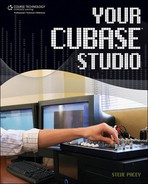Changing Object Lengths Using the OST
The OST can also change the length of a selected object. To do that, select the object and position the OST on the right side of the object. A double-sided arrow should appear pointing left and right (see Figure 8.5).
Figure 8.5. The OST displaying the Object Sizing tool, used to change length.

While the double arrow is present, click and drag the note to the right until it reaches the length you need, and then release the mouse button. The object should now be adjusted to the new length.
When using the OST to alter lengths in the Project window, you have three sizing options available from the button’s drop-down menu: Normal Sizing, Sizing Moves Contents, and Sizing Applies Time Stretch.
When the first option, Normal Sizing, is selected, the OST uses the same basic selection and sizing methods for parts as it does in the Key Editor when used with notes in the note display. Note that when you use the OST to change the size of the part, the part may get bigger or smaller, but the notes and events within the part do not move or change. This means that although the part itself is larger, nothing has been moved or changed within the part.
You may be curious as to how or why sizing a part using Normal Sizing could be effective while editing. There are times you may need to extend a part to the end of a measure(s) in order to make it fit into a predetermined space. For instance, let’s say you have a verse in your song that is eight measures long. You have a string part that comes in at measure two and ends at measure five. Even though the part falls within the eight measures, you can extend the front of the part to come in at the start of the verse and extend the end of the part to the end of the verse without altering the actual part. Now when you copy and paste the part later, you won’t have to worry about changing the timing or location of that individual track. It will always fall where it needs to within the verse. The extra length you added was merely for spacing. It adds nothing and does not affect the musical arrangement in any other way. Keep in mind that using Normal Sizing on an individual MIDI note in any editor will change the duration of the note.
The second sizing option on the OST button’s drop-down list is Sizing Moves Contents. The difference between this and Normal Sizing is that when you resize the part with Sizing Moves Contents, the notes/audio files within the part actually change positions as you make adjustments.
The third option on the OST button’s drop-down list is Sizing Applies Time Stretch. This option can be useful when you need to convert a groove that has been recorded at one tempo to fit into a new tempo.
Both Sizing Moves Contents and Sizing Applies Time Stretch can be very tricky to work with. Because of this, you can assume I’m talking about Normal Sizing in this chapter when I mention sizing parts. Later in the chapter, however, I will touch on Sizing Applies Time Stretch. For more information on Sizing Moves Contents and Sizing Applies Time Stretch, please refer to your Cubase manual.
Just as you can move multiple notes at once using the OST multiple object selection box, you can also size multiple objects at once. Simply select the range of objects you would like to size with the OST the same way you would to move multiple objects. Once you have selected the notes, move the OST to the left or right side of the selected objects, and the OST lengthening tool will appear. The tool will size everything between the selected parts.
